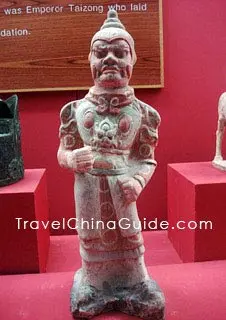Military Power of Tang Dynasty
The Tang Dynasty (618 - 907) had superb military power starting from the reunification of the whole nation at the end of the Sui Dynasty (581 - 618) until around 907.
 |
| Pottery Figure of General, Tang Dynasty |
Upon founding the Tang Dynasty, the emperor instituted strict military leadership. He centralized authority puting the military power under the control of the emperor. At that time, the national military organizations were Twelve-Guardian Community and Six-General Community of the Prince’s Palace. Additionally, the Yulin Army, the Longwu Guardians and the Shenwu Guardians were selected to protect the emperor and the imperial palace. Meanwhile, the strict regulations imposed on the army helped the Tang military to become more powerful. Later the emperor also appointed the eunuch to supervise the army, which turned out to be a curse helping the rising of the later rebellious forces.
Admittedly, the powerful military strength was based on the prosperous social economy and advanced science and technology. Two other important factors also contributed to the Tang military success. First, the emperors accepted and appointed many excellent generals from other ethnic minorities, such as Gaogouli, Qidan, Mojie and Tujue. Second, the Tang emperors carried out some cultural measures to mobilize and accelerate the unity of all the nations. As a result, the soldiers were helped a lot by strong national pride.
Thanks to the wise leadership of the emperors and the national unity, during that period, many outstanding generals emerged, such as the generals of the Han Nation, Xue Rengui, Guo Ziyi, Li Sheng, Gao Pian etc. and An Lushan, Shi Siming (general of Barbarian Minority), Li Guangbi (general of Qidan Minority), Gao Xianzhi (general of Gaogouli Minority) etc.
Xue Rengui (614 - 683), also known as Xue Li, is a famous general of the Tang Dynasty as well as a strategist and politician. In his life, Xue made great contributions to the social stability by successfully subduing the Tujue Minority, Gaogouli Minority, Tiele Minority and other enemies.
An Lushan (703 - 757), was appointed as the governor in charge of both civil and military affairs of one or two provinces. At that time, An was an influential minister of the court. Later, he founded a rebellious force against the imperial court. An Lushan also waged the An Shi Rebellion which severely attacked the Tang military power.
In the late Tang Dynasty, the Fubing Military System (in which soldiers did not belong to a fixed commander and supported themselves by farming) was changed into the Mubing System (in which soldiers were recruited by a particular commander and followed him). This system made it possible for generals safeguarding the frontiers to easily form strong military forces against the court.
Eventually, under pressure from domestic separatist forces and invasion by outside ethnic minorities along with the effect of An Shi Rebellion, the Tang military force gradually withered and died.
- Last updated on Aug. 08, 2025 by Gabby Li -